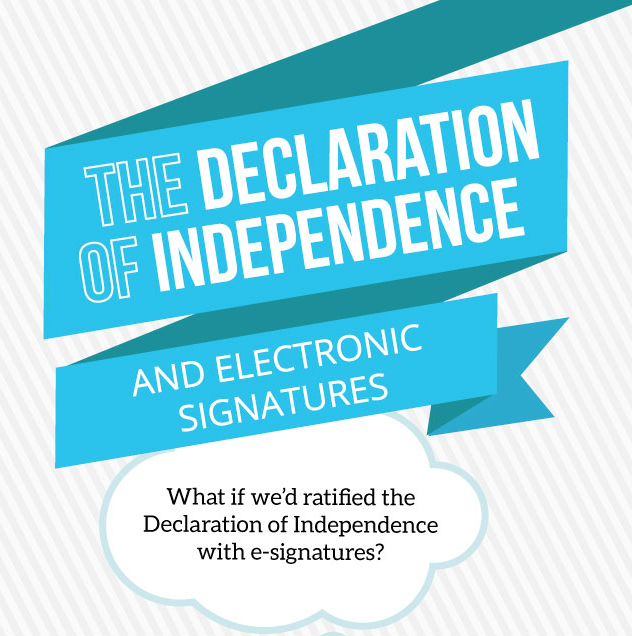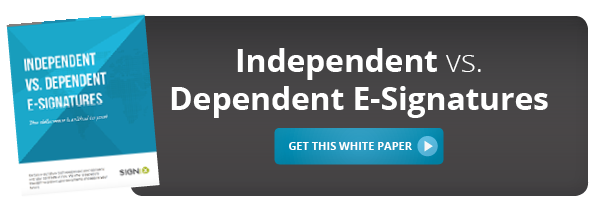We dream big dreams here at SIGNiX—especially if they involve a bit of time travel. Imagine if, in 1776, the Declaration of Independence was signed via electronic signature. The use of e-signatures would have allowed the delegates to sign all on the same day—no matter where they were. Most importantly, the delegate signatures’ validity could still be proven today—and for every Independence Day to come.
 Our senior vice president of product management, John Harris, recently shared our infographic on e-signature independence and more of his thoughts with CMSWiRE on the longevity, ownership and control, safety and transparency Independent E-SignaturesTM provide for the past, present and the future.
Our senior vice president of product management, John Harris, recently shared our infographic on e-signature independence and more of his thoughts with CMSWiRE on the longevity, ownership and control, safety and transparency Independent E-SignaturesTM provide for the past, present and the future.
**The content below was originally published by CMSWiRE. Click here to view the article in its original form.
What If the Founding Fathers Had E-Signatures?
By David Roe
Say what you want about the merits of e-signatures. But in this hypothetical case, one thing is certain: had they been around in the summer of 1776, they would have changed the course of history — if not for the United States, at least for John Hancock.
Hancock represented Massachusetts when the Continental Congress met in Philadelphia with the intention of voting for independence from England.
His signature is the biggest, most flamboyant and easily recognizable of any of the 56 delegates who signed the Declaration of Independence. The document was approved by Congress on July 4, 1776 and, most historians believe, signed piecemeal over the course of the four weeks.
By 1840, "John Hancock" had evolved to a synonym for a signature, thanks to its boldness and legibility. So the question remains: Would the man have found the same level of immortality had be affixed his hand electronically?
Perhaps not.
But John B. Harris, senior vice president of product management at SIGNiX, claims the whole process would have been a lot quicker. And from a historical perspective, it would also be a lot easier to trace the order and dates on which the signers affixed their names — and to authenticate those signatures even now.
SIGNiX even produced an infographic to demonstrate the importance of independent signatures, just in time for Independence Day.

A Real Issue
So how trustworthy and how long lived are independent e-signatures? It depends on the vendor that provides the e-signature and how long that vendor is likely to survive — or, more to the point, how long an enterprise retains a commercial relationship with that company, Harris said.
We've been talking a lot about e-signature vendors in the past few months, especially as more enterprises look to automate processes from data capture to archiving or destruction.
Michael Laurie, co-founder and VP of product strategy at Silanis, noted that e-signatures are a key element of customer experience, a key element of digital businesses.
Mark Grilli, VP of Document Services at Adobe’s EchoSign, noted lack of support from C-suite executives was holding back broader adoption of e-signatures.
Russ Gould, senior director of product marketing at Kofax, speculated the drag on the market is caused by simple resistance to change, particularly among professionals like risk averse lawyers.
Independent E-Signatures
Harris agrees, but claims the real problem is user comfort levels. People just aren't comfortable giving up the John Hancock as they know it just yet.
“In the old world, the standard is ink. In our world, the standards are a variety of documents and cryptographic elements that go back as far as the 1970s, some of which underpins security on the Internet,” he said.
This is the key to independent e-signatures, or e-signatures that don’t depend on proprietary technologies.
“This means that a third party expert can come and look at independent signatures and say this is based on whatever standard we have been using for that particular document,” Harris said.
The benefits include:
- Longevity — They are valid indefinitely because they adhere to international standards rather than the life of a technology or vendor
- Ownership and Control — The user of the e-signature technology controls where the documents are stored, without regard to the server of the technology vendor
- Transparency: Independent e-signatures provide the user with immediate and complete access to the evidence supporting their validity
Back to 1776
And so we come back to the Founding Fathers. What if America’s Founding Fathers had ratified the Declaration of Independence with electronic signatures via the as yet unknown Internet instead of quills and ink?
All 56 delegates could have signed on July 4 (assuming the New York delegation had gone along with the pack). Instead, took nearly a month — until Aug. 2 — for everyone to sign.
The delegates' electronic signatures would have been backed by a detailed audit trail.
The validity of those signatures could still be proven today, assuming the signers had used Independent Electronic Signature technology.
Alas, but what about poor John Hancock? Where would he have found his ongoing claim to fame?
%20formatted-1.png?width=2528&height=739&name=SIGNiX%20Logo%20Main%20(white)%20formatted-1.png)


